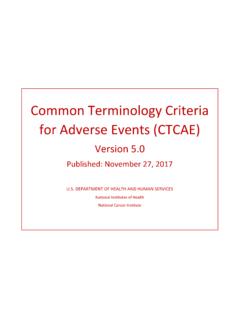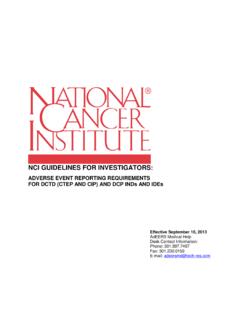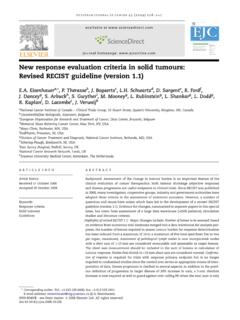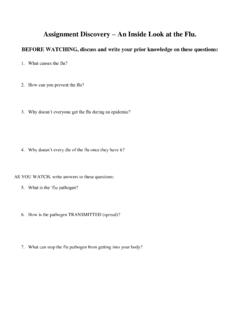Transcription of LOOK INSIDE FOR - National Cancer Institute
1 INSIDE PMBN ovember 2008 Bikes & TrikesHit the Brakes on Protocol GOG-0218!Consider this: a person bicycling at 10-15 mph (15-25 km/h), using just the energy required to walk, is generally the most energy-effi-cient means of transportation available. Air drag (with up to 75% of it caused by the rider's body) increases dramatically as speed in-creases, requiring more work. Every clinician who dispenses, prepares or administers investigational agent would like the process to be as efficient and drag-free as riding a bicycle. That said, please increase efficiency and decrease drag on GOG-0218. Why? Because errors on this study represent more than half of all errors reported to PMB.
2 What kind of errors, you ask? Using Phase A drug supply for Phase B treatment. Some pharmacies have used left-over vials from Phase A to start Phase B cycle 7. idea! The patient may have been randomized to active agent in phase A and placebo in phase B! Using wrong patient's drug supply. This error seems to occur when the regular pharmacist is away, and someone else covers. Blind-ed supplies patient-specific 10 digit patient ID numbers (###-0218-###) reflect the site code, study number and patient number enrolled at that site and may look very similar. If the site enrolls multiple patients, patient ID numbers may differ only at the tenth digit. Making dose modification errors for modest patient weight changes.
3 GOG-0218 keeps the same bevacizumab/placebo and paclitaxel dose if the weight change is less than 10%! PMB calculates the number of vials to send based on patient weight at enrollment in Phase A. When registering for Phase B treatment or faxing an order to PMB, please note the Phase A enrollment weight unless it changes by at least 10%. Using commercial bevacizumab (Avastin) in place of the patient-specific NCI-supplies of active drug or placebo. Duh. PMB will not replace commercial agent, and you cannot charge the patient. Removing vials from the original tamper-evident box to facilitate storage or combine supplies from different shipments into one box. This removes important identification ( , Phase A or B, Julian date/lot number).
4 Vials will still have the patient ID on them, but there is no way to discern supplies for different Phases or shipments. Mixing Phase A and B vials presents a problem at cross-over. In the conduct of GOG-0218, most drag is created by humans involved in the study. Slow down, decrease your drag, and do this: Keep phase-specific accountability logs. Require GOG patient-specific ID numbers on local physician order sets and require prescribers to mark orders, "Patient is on a clinical trial." Double-check that the patient ID number corresponds to the correct initials for the patient. Return vials left-over at Phase A's end to CTEP pronto. Mandate that the pharmacist highlight the patient's name, GOG patient ID number and Phase of treat-ment (A or B) with a yellow marker on each patient s drug supply container.
5 Keep the same bevacizumab/placebo dose if the weight change is less than 10%! Leave supplies in their original tamper-evident box until they are used. Pharmaceutical Management Branch/ Cancer Therapy Evaluation Program/Division of Cancer Treatment and Diagnosis/ National Cancer Institute6130 Executive Blvd * Suite 7149 * Rockville, Maryland 20852 * Phone: (301) 496-5725 * Order fax: (301) 480-4612 * Other fax: (301) 402-0429 *E-mail: PMB thanks Registration Coordinators for their winning response to our pleas in August. Specifically, we thank you for facilitating completion and submission of Investigator Registration documents before your investigators registrations NCI s Cancer Therapy Evaluation Program is making a concerted effort to conserve resources, and PMB is asking for your help again to streamline the registration process.
6 We ask a lot, we know, we try not to tire you out. But, to save time, funds, and paper, we would like to send your investigators' annual re-registration documents to you either by e-mail or on a CD. To receive your annual investigator registration packets electronically, please e-mail with the subject line "Electronic Investiga-tor Re-Registration Documents," or call CTEP Registration Help Desk at (703) Coordinators!Shift Gears, Please!!! look INSIDE FOR Slide show? See Page 3 Dudes on page 2 Pharmaceutical Management Branch/ Cancer Therapy Evaluation Program/Division of Cancer Treatment and Diagnosis/ National Cancer Institute6130 Executive Blvd * Suite 7149 * Rockville, Maryland 20852 Phone: (301) 496-5725 * Order fax: (301) 480-4612 * Other fax: (301) 402-0429 * E-mail: INSIDE PMB - November 2008 Page 2 RANKC ycle Racing TacticCell Cycle Tactic1 Drafting: Riding directly behind and slightly to the side of another rider (in his slipstream), to save a considerable amount of energyThe cell s division cycle is a series of coordinated DNA replication and division.
7 The cyclin dependent kinase (Cdk) family of serine/threonine kinases is at the core of mammalian cell division cycle. The dependent part of the Cdk name means that these kinases full activity is dependent on association with one of the many regulatory subunits known as cyclins. Different cell cycle phases require different Cdks. Specific Cdks are fully active when their cyclin partners are : A group that breaks away from the main field, bunch or peloton, to have more space and freedomThe p53 gene stops the cell cycle when even tiny DNA double-strand breaks occurs. The cell produces more p53 a breakaway protein, if you will when it is exposed to DNA-damaging agents ( , UV radiation), and p53 induces synthesis of another protein that inhibits Cdk-cyclin com-plex function.
8 3 Domestique: A road bicycle racer who works sole-ly for the benefit of his or her team and leader Cdks induce other proteins to perform their functions and relay a cell from one stage to the next by phosphorylating (adding a phosphate group) key amino acid residues, and cyclins bind to Cdks to control their ability to phosphorylate those target sprinter: A road bicycle racer or track racer who finishes a race very explosively by ac-celerating quickly to a high speedIn addition to the protein phosphorylation cascade that acts as a domes-tique, the cell cycle has checkpoints to monitor completion of critical events and delay progression to the next stage if necessary.
9 Cancer of-ten mutates the cell cycle and its checkpoints. Because cancerous cells divide rapidly and ignore intracellular control mechanisms, they would be considered the cycling wagon: The bus that follows the race to pick up injured, exhausted or straggling ridersInternal or external insults constantly damage cells and threaten their sur-vival. Cell cycle checkpoint mechanisms also make necessary repairs. Cell cycle DNA damage, replication, spindle integrity, and restriction checkpoints would be considered the cell s broom a Vicious Pace: On a Bike or in the Clinic!This puts a new spin on Cancer at the cellular level, doncha think?Pedal Over to the CTSU Members Web SiteThe Cancer Therapy Evaluation Program (CTEP) created Identi-ty and Access Management (IAM) accounts primarily to provide access to the Cancer Trials Support Unit's (CTSU) members web site.
10 Once Associates activate their CTEP-IAM accounts, an applica-tion request is automatically forwarded to the CTSU Help Desk and they begin the approval process for access to the CTSU members web site. It will typically take the CTSU 2 to 3 days to review your application. The CTSU team will notify you by e-mail of the outcome of their review. Once you receive the ap-proval e-mail from the CTSU, you will be able to use your new CTEP-IAM username and permanent password to access the CTSU members website. *Associates need not take any other steps in IAM to obtain ac-cess to : Pumped Up and Popping Wheelies! We re all excited over here at the PMB because the next few months are full of federal holidays.

















